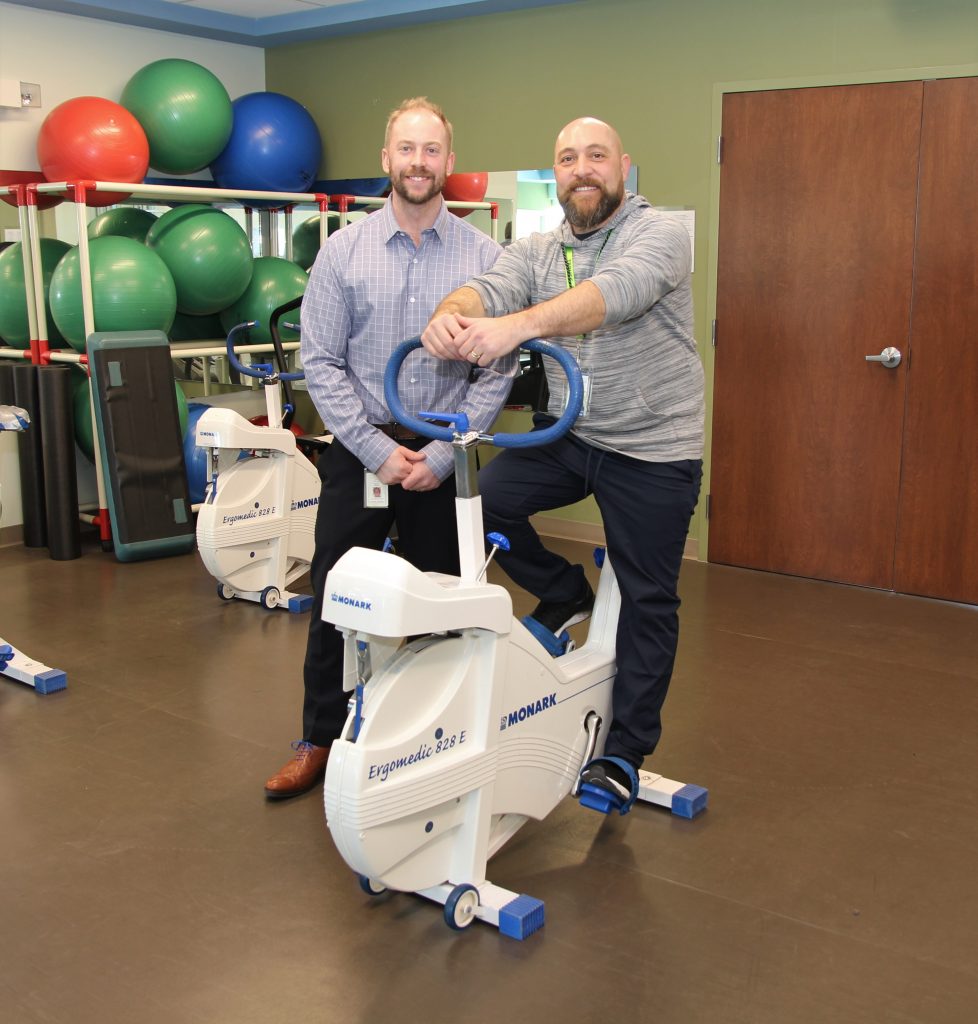Your Road to Cardiac Recovery
by Sarah Chadwick, Registered Kinesiologist with the Rehabilitation and Healthy Lifestyles Program
 Kyle Baysarowich, Manager of the Rehabilitation and Healthy Lifestyles Program at the Thunder Bay Regional Health Sciences and Frank Rizzuto, former participant and current volunteer with the program.
Kyle Baysarowich, Manager of the Rehabilitation and Healthy Lifestyles Program at the Thunder Bay Regional Health Sciences and Frank Rizzuto, former participant and current volunteer with the program.“What happens after my cardiac event?”
It’s a common question that leaves some patients feeling fearful and confused during their recovery from cardiac disease. February was Heart Month, and Kyle Baysarowich, Manager of the Rehabilitation and Healthy Lifestyles Program at the Thunder Bay Regional Health Sciences Centre (our Hospital) outlined everything you need to know about cardiac rehabilitation and your road to recovery.
The Hospital’s Rehabilitation and Healthy Lifestyle Program is comprised of a multidisciplinary team that specializes in cardiovascular disease care, and chronic disease management. “The statistics surrounding participation in cardiac rehabilitation improving quality of life, and decreasing rate of morbidity and mortality is overwhelming,” said Baysarowich. “Our program is guided by the Canadian Association of Cardiovascular Prevention and Rehabilitation which outlines the dedicated resources needed to achieve optimal health outcomes for our participants using exercise prescription, education, and behavioural or lifestyle modifications to lower cardiac risk factors.”
The dedicated team is comprised of a Medical lead, Nurse Practitioners, Patient Navigator, Registered Nurses, Registered Kinesiologists, Dietitian, Social Worker, and clerical staff who all share the same passion for patient and family centred care, and cardiovascular health.
What happens when an individual is referred to the Rehabilitation and Healthy Lifestyles Program? “Each participant will complete an orientation to the program, intake assessment, and attend an introduction to exercise education session. Once that process is complete, clients are ready to begin exercising,” said Baysarowich. “We use a case management structure that ensures each person is offered individualized exercise programming specific to their diagnosis and other medical conditions, while being monitored and progressed regularly to achieve best results. Participants also actively attend individualized counseling and group education sessions by the multidisciplinary team to encourage a holistic approach to health and wellness.”
Participants have access to the program and its resources for six months. “That being said we have multiple streams, such as home programming or shortened programs, so we can meet the needs of each individual,” said Baysarowich. “Our program is also committed to regional accessibility, therefore with the incorporation of Telehealth, we are able to provide all components of our rehabilitation program to 12 regional sites across Northwestern Ontario.”
The Rehabilitation and Healthy Lifestyles Program provides participants with the tools, knowledge and positive outlook they need to recover from their cardiac event.
“I thought I was healthy, besides having a heart attack, when I was referred to the Rehabilitation and Healthy Lifestyles program,” said Frank Rizzuto, former participant and current volunteer with the program. “Starting the program, I realized I was scared of what could happen during exercise, and of my lack of knowledge on heart health. However, it was inspiring to have each staff member fully present in my care. They take the time to foster a healthy and positive environment where I could ask questions and gain confidence in my abilities. If I could leave one message for others entering the program, it would be to utilize the staff and educational opportunities and to ask as many questions as you can. Go in with an open mind and take part in your own recovery, because you will be surprised how much progress you can make in just six months!”
The future is bright for cardiovascular care in Northwestern Ontario. The Thunder Bay Regional Health Sciences Foundation’s Our Hearts At Home Campaign aims to bring a full cardiovascular surgery program to our Hospital.
“As our Hospital and its partners work towards bringing full cardiovascular surgery services to Thunder Bay, our team at the Rehabilitation and Healthy Lifestyles program is looking forward to seeing how our program grows alongside this initiative to improve patient care for everyone in the Northwest,” added Baysarowich.
For more information about cardiovascular rehabilitation, visit www.tbrhsc.net or contact the Hospital’s Rehabilitation and Healthy Lifestyles program by calling (807) 684-6000.